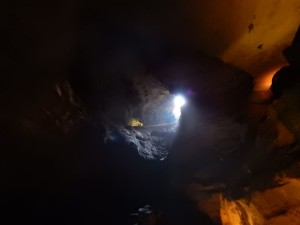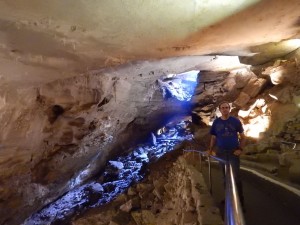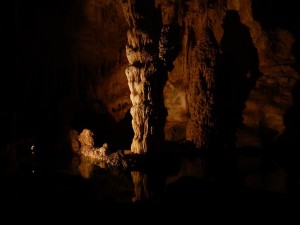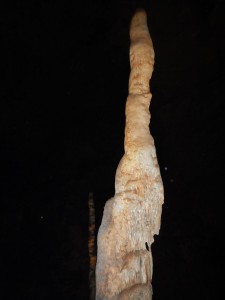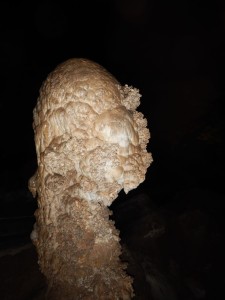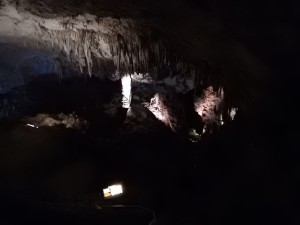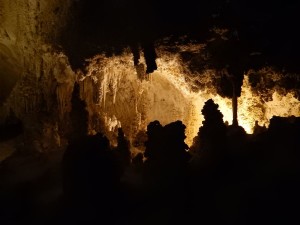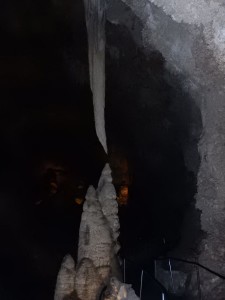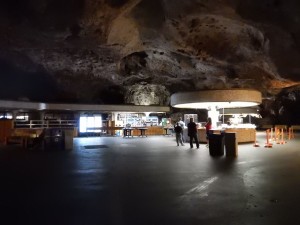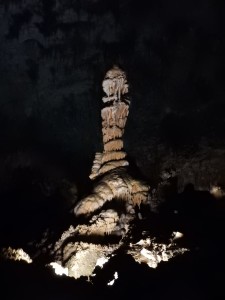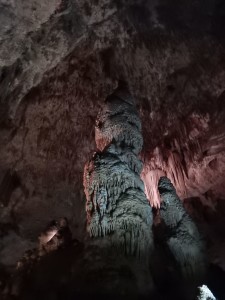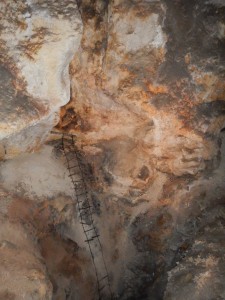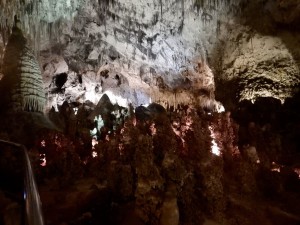July 24
The sea that once covered much of what’s now the southwest of the United States has been a running theme of the parks I’ve visited on this trip. In fact, there was more than one sea, at different times, but the one that keeps reoccurring on my trip is called by geologists the Delaware Sea, and it existed when all the Earth’s landmasses were gathered into the one supercontinent Pangaea.
Along the coasts of the Delaware Sea during the Permian period, around 250 million years ago, was a great coral reef. Over millions of years the corals laid down the reef, the growth of previous generations compressing into limestone beneath them. Eventually, as the continents drifted apart, and as mountain ranges were thrust upward, the Delaware Sea was cut off from the oceans and slowly evaporated (leaving behind the salt deposits that played a role in forming Arches National Park).
Today what was once a coral reef is now the Guadalupe Mountains.
 As the sea dried, the water became more salty. The brine combined with other minerals in the water dissolved out holes in the limestone of the former reef, forming a swiss-cheese, spongelike structure. Later, after the limestone was lifted above the water table, rainwater seeped down through seams in the rock and mixed with sulfides rising from natural gas and petroleum deposits further down, producing sulfuric acid that enlarged the swiss-cheese holes into massive caverns.
As the sea dried, the water became more salty. The brine combined with other minerals in the water dissolved out holes in the limestone of the former reef, forming a swiss-cheese, spongelike structure. Later, after the limestone was lifted above the water table, rainwater seeped down through seams in the rock and mixed with sulfides rising from natural gas and petroleum deposits further down, producing sulfuric acid that enlarged the swiss-cheese holes into massive caverns.
There are hundreds or thousands of caverns around the world; Carlsbad is one of only six to have been largely formed by sulfuric acid rather than underground running water (according to the park ranger giving the talk).
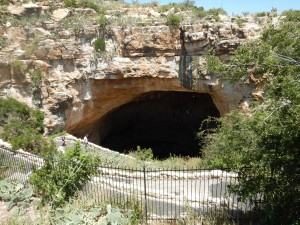 The modern story of the cavern begins in 1898 when a 16-year-old cowboy named Jim White was riding the range and saw what he thought was a column of smoke from a brushfire. It turned out to be bats flying out of a large cave entrance— which apart from the paved walkways looks the same today as it did then. White, who already had a reputation for telling tall tales, didn’t improve his reputation when he later claimed there were exactly 4 million bats— which he knew because he’d counted every one as it flew out of the cave.
The modern story of the cavern begins in 1898 when a 16-year-old cowboy named Jim White was riding the range and saw what he thought was a column of smoke from a brushfire. It turned out to be bats flying out of a large cave entrance— which apart from the paved walkways looks the same today as it did then. White, who already had a reputation for telling tall tales, didn’t improve his reputation when he later claimed there were exactly 4 million bats— which he knew because he’d counted every one as it flew out of the cave.
White immediately explored the cave, all by himself and with nothing but a single kerosene lantern. He fell in love with it and spent the rest of his life exploring more of it and trying to persuade other people to come see it with him— without much success until the National Geographic Society sent an expedition with a photographer in 1926. White guided the expedition (lugging 150 pound cameras into a cave with no developed trails) and the article that resulted made the cavern famous. Jim White lived to see his beloved cavern become first a National Monument, then a National Park in 1930, and he gave guided tours to the visitors until the end of his life.
On my own trip through Carlsbad Caverns, I took a lot of pictures, experimenting with different settings on my camera to try and get good results. With my little tripod I could set it down to take long exposures, I could set it to be very sensitive, I could fiddle with all sorts of things. But it’s hard to photograph a cavern well (I’m sure a professional photographer would have known better what to try). With some settings, I could take pictures that looked like the cavern was in broad daylight, but that was so unlike what you actually see that there seems little point, though I include a few of those below. Other settings left things too dark to see anything in the picture, or flattened things out so that the rock formation in the foreground fails to stand out from the walls in the background, and the picture is just an incomprehensible jumble. It’s hard to take a good picture in a cave!
Still, I took so many that some were bound to turn out okay by luck. So, without any more ado (and very little more commentary), here’s a selection of those that turned out okay.
Besides the self-guided walk along the main trail, I took the ranger-led tour through the “King’s Palace”— a set of three chambers especially rich in “decorations,” called the King’s Palace, the Queen’s Chamber, and the Papoose Room. (Almost all the rooms and formations in Carlsbad Caverns were originally named by Jim White.) Here are some pictures from those areas:
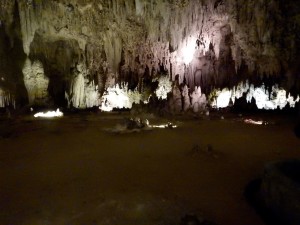 |
 |
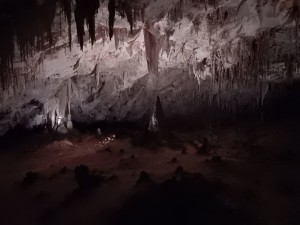 |
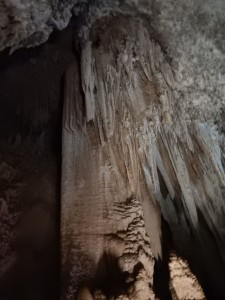 |
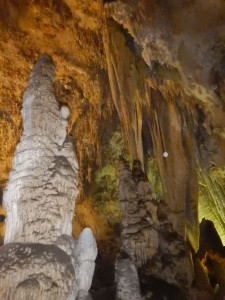 |
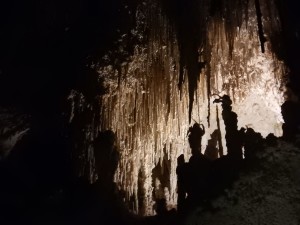 |
| The “Veiled Statue” | 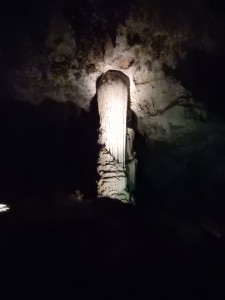 |
Below the King’s Palace section is the underground rest area, or as I think it obviously is, the Supervillain Lair.
Beyond the rest stop is the Big Room— aptly named, it’s the largest limestone chamber in the western hemisphere, with an area of 600,000 square feet.
 |
Here it is turned into bright daylight by my camera’s most sensitive setting plus a long exposure. |
| But this is closer to what it looked like to be there. | 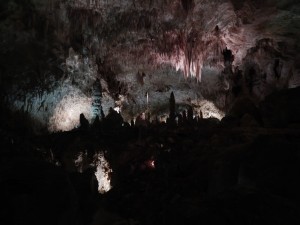 |
Some features from the Big Room:
Speaking of lighting: after Carlsbad Caverns became a National Park, the park service developed the current visitor trail (which has been updated since) and installed the lighting throughout the cave. To do the lighting, the park service hired Academy-award-winning lighting designers from Hollywood, who carefully designed the system to conceal the actual light fixtures from view, while lighting the cavern to best dramatic and artistic effect.
One thing they did not do was use colored lighting. Although it appears there are multiple colors of light used in the cave, all the lights are the same neutral white designed to bring out the natural colors of the rocks. All the variations in color you see belong to different minerals in the rocks.
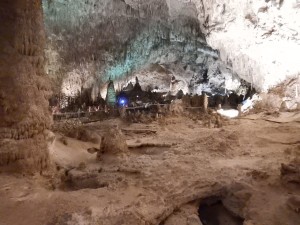 |
Another exaggerated-brightness overview, of a different part of the Big Room. |
| “Bottomless Pit”— actually 170 feet deep. |  |
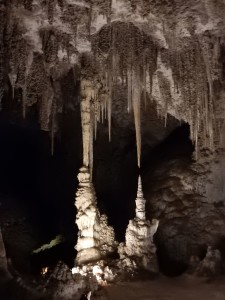 |
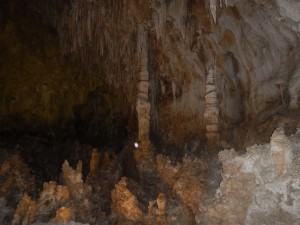 |
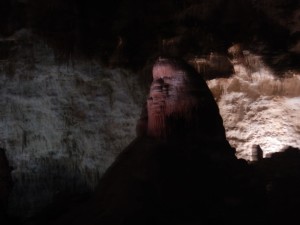 |
The Cave Man |
| Rock of Ages | 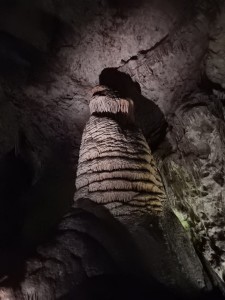 |
There’s a lot more, but those are the pictures that came out best. After going through the Big Room (actually I went around the whole trail, starting at the natural entrance, twice) my tour of the cave was done.
This evening I returned for the Ranger Program on Carlsbad Caverns’ bats, and watched their evening flight out to feed (they eat prodigious quantities of flying insects). I have no pictures from that; electronic devices including digital cameras, iPhones, etc. are banned. It’s believed that the electronics in such devices emit some sound, inaudible to humans, that alarms and distresses the bats.
The Ranger said this hasn’t been scientifically tested, but when digital cameras and iPhones started to replace film, Rangers noticed that as soon as the crowd started taking pictures the bats would stop leaving the cave. Then people would put down their cameras, the flight would resume, people would start taking pictures again and the bats would stop again. So although the cause hasn’t been researched, they’ve banned the use of cameras and other electronics during the evening flight.
And with that— I’ve seen my last National Park of my Epic July Road Trip. I’m sorry to reach the end, but also ready to get back home.
Tomorrow: The Drive Home
I don’t expect to have anything to report about my last driving day— there aren’t any sights along the way, unless I encounter something unexpected. But I think I’ll write one final blog post, a bit of a retrospective on the trip overall, and perhaps include a few items that didn’t make it into my posts along the way.


